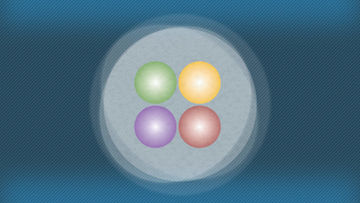
Two Teams Have Simultaneously Unearthed Evidence of an Exotic New Particle
by Ryan F. Mandelbaum, Gizmodo.com
Nov. 17, 2017

A tetraquark (Artwork: Fermilab)
A few months ago, physicists observed a new subatomic particle—essentially an awkwardly-named, crazy cousin of the proton. Its mere existence has energized teams of particle physicists to dream up new ways about how matter forms, arranges itself, and exists.
Now, a pair of new research papers using different theoretical methods have independently unearthed another, crazier particle predicted by the laws of physics. If discovered in an experiment, it would provide conclusive evidence of a whole new class of exotic particles called tetraquarks, which exist outside the established expectations of the behavior of the proton sub-parts called quarks. And this result is more than just mathematics.
“We think this is not totally academic,” Chris Quigg, theoretical physicist from the Fermi National Accelerator Laboratory told Gizmodo. “Its discovery may well happen.”
Bust first, some physics. Zoom all the way in and you’ll find that matter is made of atoms. Atoms, in turn, are made of protons, neutrons, and electrons. Protons and neutrons can further be divided into three quarks.
Physicists have discovered six types of quarks, which also have names, masses, and electrical charges. Protons and neutrons are made from “up” and “down” quarks, the lightest two. But there are four rarer, heavier ones. From least to most massive, they are: “strange,” “charm,” “bottom,” and “top.” Each one has an antimatter partner—the same particle, but with the opposite electrical sign. As far as physicists have confirmed, these quarks and antiquarks can only arrange themselves in pairs or threes. They cannot exist on their own in nature.
Scientists in the Large Hadron Collider’s LHCb collaboration recently announced spotting a new arrangement of three quarks, called the Ξcc++ or the “doubly charged, doubly charmed xi particle.” It had an up quark and two heavy charm quarks. But “most of these particles” with three quarks “containing two heavy quarks, charm or beauty, have not yet been found,” physicist Patrick Koppenburg from Nikhef, the Dutch National Institute for Subatomic Physics, told Gizmodo back then. “This is the first in a sense.”
With the knowledge such a particle could exist (and with the knowledge of its properties like its mass), two teams of physicists crunched the numbers in two separate ways. One team used extrapolations of the experimental data and methods they’d previously used to predict this past summer’s particle. The other used a mathematical abstraction of the real world, using approximations that take into account just how much heavier the charm, bottom, and top are than the rest to simplify the calculations.
No Comments




